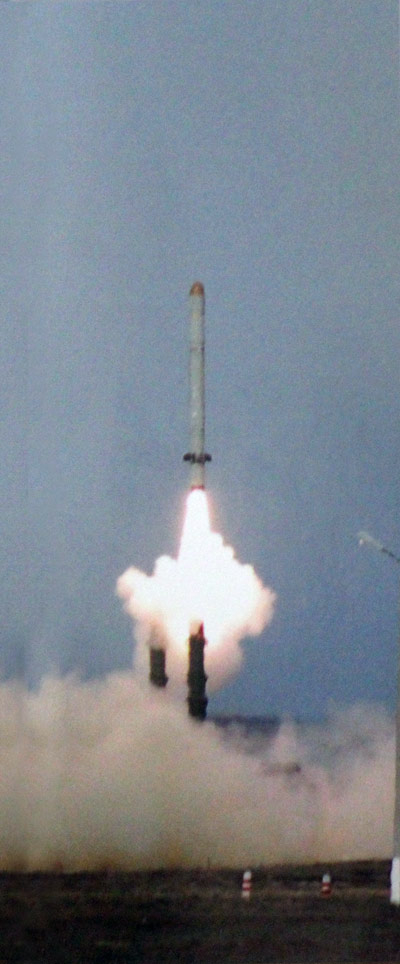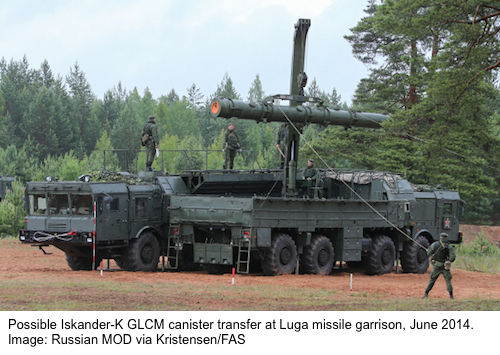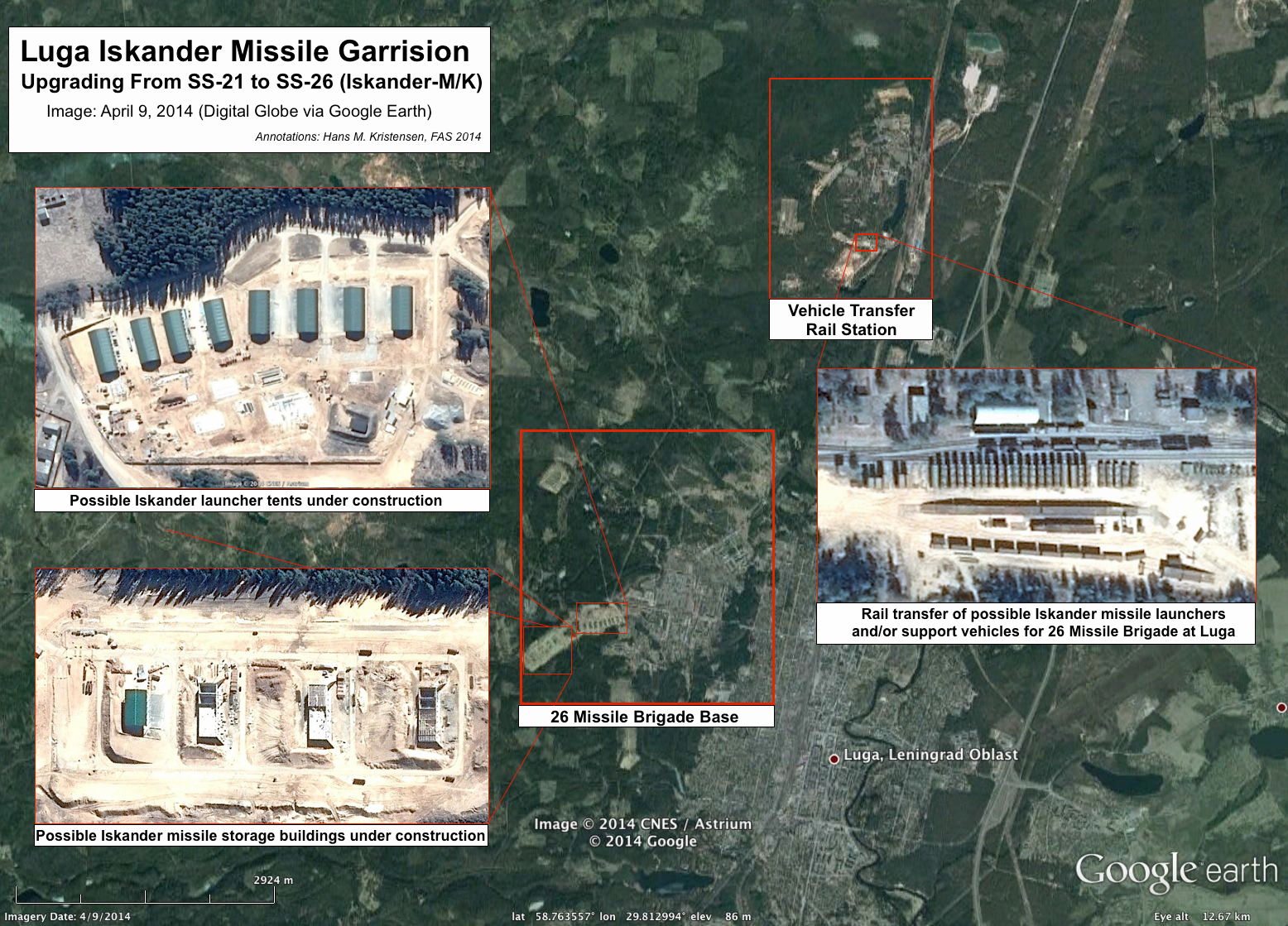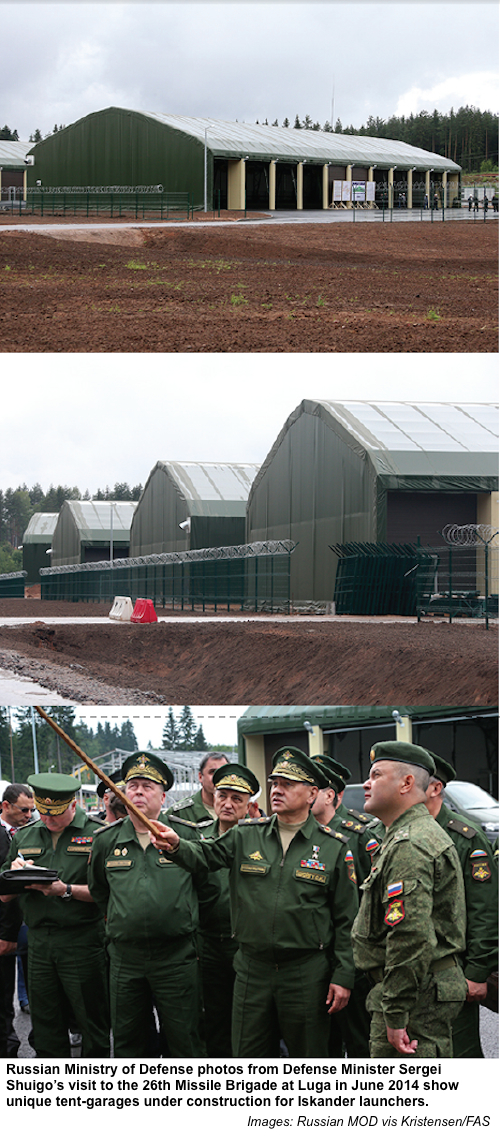Russia Declared In Violation Of INF Treaty: New Cruise Missile May Be Deploying

A Russian GLCM is launched from an Iskander-K launcher at Kapustin Yar in 2007.
The United States yesterday publicly accused Russia of violating the landmark 1987 Intermediate-Range Nuclear Forces (INF) Treaty.
The accusation was made in the State Department’s 2014 Compliance Report, which states:
“The United States has determined that the Russian Federation is in violation of its obligations under the INF Treaty not to possess, produce, or flight-test a ground-launched cruise missile (GLCM) with a range capability of 500 km to 5,500 km, or to possess or produce launchers of such missiles.”
The Russian violation of the INF is, if true, a very serious matter and Russia must immediately restore its compliance with the Treaty in a transparent and verifiable manner.
Rumors about a violation have swirled around Washington (and elsewhere) for a long time. Apparently, the GLCM was first launched in 2007 (see image to the left), so why the long wait?
The official accusation it is likely to stir up calls for the United States to abandon the INF Treaty and other arms control efforts. Doing so would be a serious mistake that would undercut benefits from existing and possible future agreements. Instead the United States should continue to adhere to the treaty, work with the international community to restore Russian compliance, and pursue additional measures to reduce nuclear dangers worldwide.
What Violation?
The unclassified Compliance Report doesn’t specify the Russian weapon system that it concludes constitutes a violation of the INF Treaty. Nor does it specify when the violation occurred. The classified version and the briefings that the Obama administration has given Congress and European allies presumably are more detailed. All the Compliance Report says is that the violation concerns a GLCM with a range of 310 miles to 3,400 miles (500 km to 5,500 km).
While public official identification is still pending, news media reports and other information indicate that the violation possibly concerns the Iskander-K weapon system, a modification of the Iskander launcher designed to carry two cruise missiles instead of two SS-26 Iskander-M ballistic missiles.
[UPDATE December 2014: US Undersecretary of State Rose Gottemoeller helpfully removes some of the uncertainty: “It is a ground-launched cruise missile. It is neither of the systems that you raised. It’s not the Iskander. It’s not the other one, X-100 [sic; X-101].” And the missile “is in development.”
The cruise missile apparently was first test-launched at Kapustin Yar in May 2007. Russian news media reports at the time identified the missile as the R-500 cruise missile. Sergei Ivanov was present at the test and Vladimir Putin confirmed that “a new cruise missile test” had been carried out.
Public range estimates vary tremendously. One report claimed last month that the range of the R-500 is 1,243 miles (2,000 km), while most other reports give range estimates from 310 miles (500 km) and up. Images on militaryrussia.ru that purport to show the R-500 GLCM 2007-test show dimensions very similar to the SS-N-21 SLCM (see comparison below).

Images on militaryrussia.ru that purport to show the R-500 GLCM 2007-test show dimensions very similar to the SS-N-21 SLCM
The wildly different range estimates might help explain why it took the U.S. Intelligence Community six years to determine a treaty violation. A State Department spokesperson said yesterday that the Obama administration “first raised this issue with Russia last year. ”The previous Compliance Report from 2013 (data cut-off date December 2012) did not call a treaty violation, and the 2013 NASIC report did not mention any GLCM at all.
So either there must have been serious disagreements and a prolonged debate inside the Intelligence Community about the capability of the GLCM. Or the initial flight tests did not exceed 310 miles (500 km) and it wasn’t until a later flight test with an extended range – perhaps in 2012 or 2013 – exceeded the INF limit that a violation was established. Obviously, much uncertainty remains.
Deployment Underway at Luga?
The Compliance Report, which covers through December 2013, does not state whether the GLCM has been deployed and one senior government official consulted recently did not want to say. And the New York Times in January 2014 quoted an unnamed U.S. government official saying the missile had not been deployed.
But since then, important developments have happened. Last month, Russian defense minister Sergei Shuigu visited the 26 Missile Brigade base near Luga south of Saint Petersburg, approximately 75 miles (120 km) from the Russian-Estonian border. A report of the visit was posted on the Russian Ministry of Defense’s web site on June 20th.
The report describes introduction of the Iskander-M ballistic missile weapon system at Luga, a development that has been known for some time. But it also contains a number of photos, one of which appears to show transfer of an Iskander-K cruise missile canister between two vehicles.

The fact that the Russian MOD report shows both what appears to be the Iskander-M and the Iskander-K systems is interesting because images from another visit by defense minister Shuigo to the 114th Missile Brigade in Astrakhanskaya Oblast in June 2013 also showed both Iskander-M and Iskander-K. During that visit, Shoigu said that Iskander was delivered in a complete set, rather than “piecemeal” as done before. That could indicate that the Iskander units are being equipped with both the Iskander–M ballistic missile and Islander-K cruise missile, and that Luga is the first western missile brigade to receive them.
A satellite image from April 9, 2014, shows significant construction underway at the Luga garrison that appears to include missile storage buildings and launcher tents for the Iskander weapon system (see image below). The base is upgrading from the Soviet-era SS-21 (Tochka) short-range ballistic missile.

Construction underway at the 26th Missile Brigade base near Luga show what appear to include missile storage buildings and launcher tents for the Iskander weapon system.
The eight garage-tents that are visible on the satellite photo also appear on the ground photos the Russian MOD published of defense minister Shuigo’s visit to Luga. The garages are in two groups bent in a slight angle that is also visible one of the ground photos (see middle photo of collage below).
Earlier this month, the acting commander of the western military district told Interfax that infrastructure to house the missiles is being built at the base where they will be stationed. And Russian news media reported that the first of the three Missile Battalions at Luga had completed training and the Iskander was accepted for service on July 8, 2014. The remaining two Battalions will complete training in September, at which time the 26th Missile Brigade is scheduled to conduct a launch exercise in the western military district.

What the Report Doesn’t Say
Troubling as the alleged INF violation is, the Compliance Report also brings some good news by way of what it doesn’t say.
For example, the Compliance Report does not say that any Russia ballistic missiles violate the INF. Some speculated last year that Russia’s development of a new long-range ballistic missile – the RS-26, a modified version of the RS-24 (SS-27 Mod 2) intercontinental ballistic missile (ICBM) – was a violation because it was test-flown at less than 5,500 km. I challenged that at the time and the 2013 NASIC report clearly listed the “new ICBM” with a range of more than 5,500 km. The Compliance Report indirectly confirms that Russian longer-range ballistic missiles have not been found to be in violation of the INF.
Nor does the Compliance Report declare any shorter-range ballistic missiles – such as the SS-26 Iskander-M – to be in violation of the treaty. This is important because there have been rumors that the Iskander-M might have a range of 310 miles (500 km) or more.
As such, the Compliance Repot helpfully confirms indirectly that the Iskander-M range must be less than 310 miles (500 km). This conclusion matches the 2013 NASIC report, which lists the Iskander-M (SS-26) range as 186 miles (300 km).
The report also indirectly lay to rest rumors that the violation might have involved a sea-launched cruise missile that was test-launched on land.
Conclusions and Recommendations
The alleged Russian violation of the INF treaty is serious stuff that calls into question Russia’s status as a trustworthy country. That status has already taken quite a few hits recently with the annexation of Crimea and the proxy-war in eastern Ukraine. But it’s one thing for a country to withdraw from a treaty because it’s deemed no longer to serve national security interests; it’s quite another to cheat while pretending to abide by it.
That’s why the U.S. accusation is so serious that Russia has violated the terms of the 1987 INF Treaty by producing, flight-testing, and possessing a GLCM with a range of more than 310 miles (500 km). Unfortunately, the lack of details in the unclassified report will leave the public guessing about what the violation is and enable Russian officials to reject the accusation (at least in public) as unsubstantiated.
Shortly after the 2007 flight-test of the GLCM now seen as violating the INF, President Putin warned that it would be difficult for Russia to adhere to the INF Treaty if other countries developed INF weapons. He didn’t mention the countries but Russian defense experts said he meant China, India, and Pakistan.
By that logic, one would have expected Russia’s first deployment of Iskander-K and its GLCM to be in eastern or central Russia. Instead, the first deployment appears to be happening at Luga in the western military district, even though the United States no longer has GLCMs deployed in Europe.
There is a real risk that Russia will now formally withdraw from the INF Treaty. Doing so would be a serious mistake. First, it is because of the INF Treaty that Russia no longer faces quick-strike INF missiles in Europe. Moreover, continuing the INF treaty is Russia’s best hope of achieving some form of limitations on other countries’ INF weapons. But instead of trying to sell INF limitations to China and India, Putin has been busy selling them advanced weapons, including cruise missiles.
In the meantime, Russia must restore its compliance with the INF Treaty in a transparent a verifiable manner. Doing anything else will seriously undermine Russia’s international status and isolate it at next year’s nuclear Non-Proliferation Treaty (NPT) Review Conference.
Some will use Russia’s alleged INF violation to argue that the United States should withdraw from the INF treaty and abandon other arms control initiatives because Russia cannot be trusted. But the treaty has served its purpose well and it is in the U.S. and European interest to maintain and promote its norms to the extent possible. Besides, the United States and NATO have plenty of capability to offset any military challenge a potential widespread Russian GLCM deployment might pose.
Moreover, arms control treaties, such as the New START Treaty or future agreements, can have significant national security benefits by allowing the United Stated and its allies better confidence in monitoring the status and development of Russian strategic nuclear forces. For arms control opponents to use the INF violation to prevent further reductions of nuclear weapons that can otherwise hit American and allied cities seems downright irresponsible.
This publication was made possible by a grant from the Ploughshares Fund and New Land Foundation. The statements made and views expressed are solely the responsibility of the author.
The FY2026 National Defense Authorization Act (NDAA) paints a picture of a Congress that is working to both protect and accelerate nuclear modernization programs while simultaneously lacking trust in the Pentagon and the Department of Energy to execute them.
While advanced Chinese language proficiency and cultural familiarity remain irreplaceable skills, they are neither necessary nor sufficient for successful open-source analysis on China’s nuclear forces.
Satellite imagery has long served as a tool for observing on-the-ground activity worldwide, and offers especially valuable insights into the operation, development, and physical features related to nuclear technology.
This report outlines a framework relying on “Cooperative Technical Means” for effective arms control verification based on remote sensing, avoiding on-site inspections but maintaining a level of transparency that allows for immediate detection of changes in nuclear posture or a significant build-up above agreed limits.